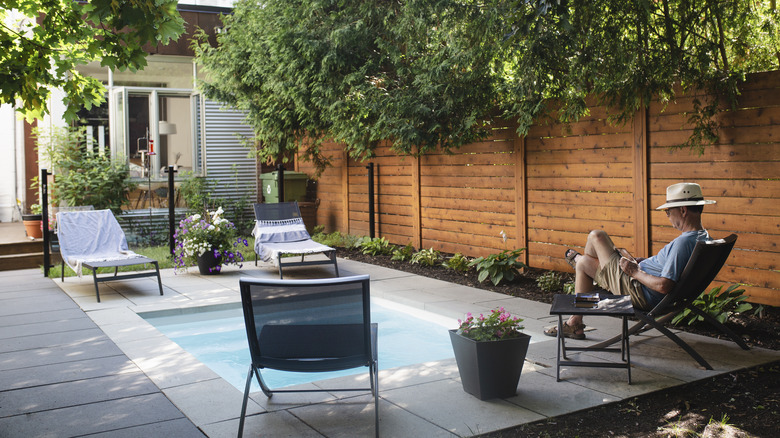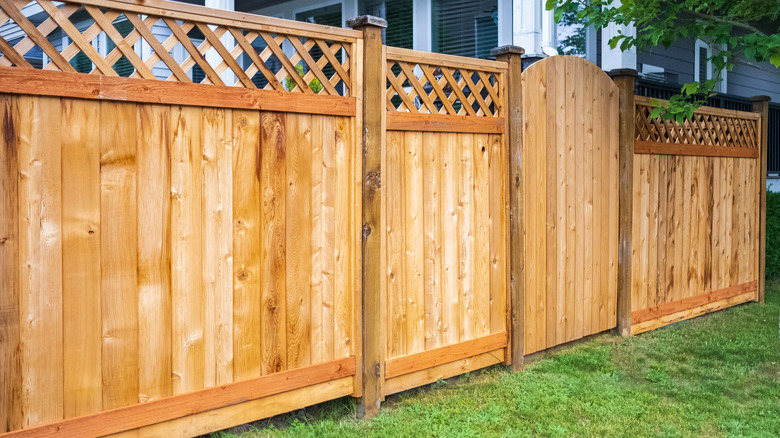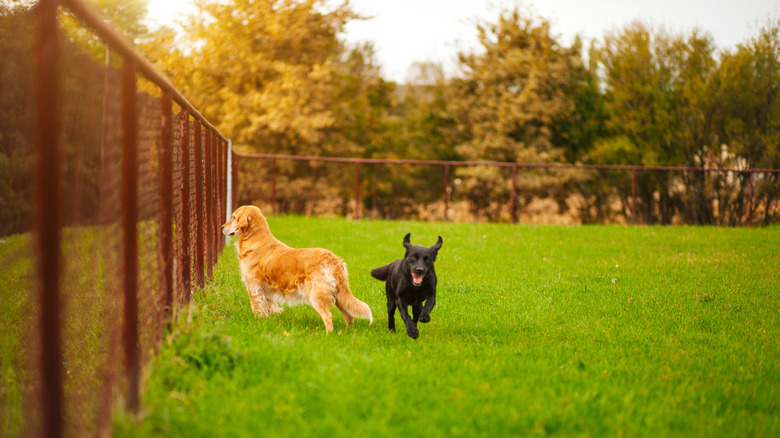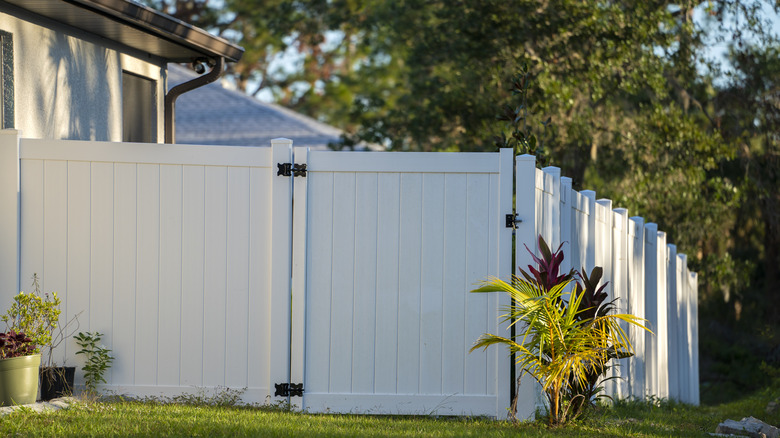The Types Of Fence That Can Help Make Your Yard Safer
We may receive a commission on purchases made from links.
A great fence doesn't just define your property line. It can also provide an important layer of safety and privacy for your family. In some cases, fences are actually mandatory. If you have a pool, for example, most municipalities will require a fence with a self-closing, self-latching gate to protect kids and pets from taking an unplanned or unmonitored dip. But even if you don't have a pool in your backyard, a fence is a practical must-have for most families. It keeps your dog from chasing squirrels and bicyclists. It also gives toddlers, and even older children, a clear boundary so you can have more peace of mind while they're playing outside. And even though the best home security systems keep getting better and more advanced, a fence is the first line of defense against both rabid animals and prowling trespassers. Wood, metal, and vinyl are three types of fencing that can help make your yard safer and more secure, but it's essential to consider the real-world risks and benefits to select the right one.
That's because when it comes to fencing materials, there really isn't a one-size-fits-all option. The best fence for safety depends on your specific needs, budget, and the level of protection you want to achieve. If privacy or soundproofing are your highest priorities, wood and vinyl are both excellent choices because they offer a solid barrier between you and nosy (or noisy) neighbors. When keeping your kids or animals safely contained, even when you're not constantly supervising, is the objective, you may want to consider metal fencing options like wrought iron, chain link, or aluminum.
Wood fences add safety, privacy, and charm
Wood fencing is a timeless choice for homeowners who want both privacy and character. A tall, solid wood privacy fence offers an extremely effective barrier that keeps pets contained, kids protected, and unwanted visitors out. The return on investment for installing this type of fence is about 50%, but there are ways to protect your expenditure, such as choosing the right kind of wood and construction method. Cedar and redwood may be more expensive upfront, but both are naturally resistant to rot and insects, while pressure-treated pine is a more budget-friendly option. When safety is your goal, opt for a fence design that relies on reinforced posts set deep into concrete, vertical boards installed close together, and sturdy gates with self-closing and self-latching hardware. Also, keep your yard's terrain in mind and install chicken wire or another type of barrier under the fence where needed.
While traditional picket or split-rail styles might look charming and increase your home's curb appeal, they are less private and, depending on what you want protection from, possibly less safe. Before committing to any wood fence design, it's important to balance function and aesthetics with local requirements. You should check your county or city's regulations and any homeowner's association rules that limit your choice of fencing material, style, or height. If you opt for a wood fence, be prepared for regular maintenance, too. Sealing, staining, and keeping an eye out for loose nails are necessary to ensure your wood fence is strong and safe. For added longevity, trim any nearby shrubs and locate sprinklers to avoid constant exposure to moisture. Adding protective elements like Goovilla 4x4 Post Caps from Amazon can also ensure your wood fence's longevity.
Metal fences can offer cost-effective curb appeal
Metal fencing combines power and performance, especially when it comes to long-term durability. Galvanized steel chain link is a classic choice. Tough, low-maintenance, and extremely cost-effective, it's ideal when you're looking for affordable fencing ideas to enclose your yard. If privacy is just as important as safety, consider adding vinyl or composite slats for a more enclosed look. If budget isn't a concern, there are other metal options that combine strength and aesthetics. Wrought iron fencing offers timeless appeal, making it perfect for front yards or properties begging for both curb appeal and security. For families with pets (or escape artist kids), pick smaller picket spacings or mesh patterns. You can also add base guards that prevent squeezing through gaps for extra safety. Modern aluminum fencing is a weather-resistant solution that can mimic the look of iron without the high cost or potential for rust. Power-coated finishes protect metal fences from corrosion, making it a smart buy, especially if you live in a coastal or humid area.
There are a few types of metal fencing that may seem tempting, but should be avoided for residential use. Chicken wire, though inexpensive and easy to install, won't stop a curious toddler or a determined dog. Razor or barbed wire fences are dangerous for humans, pets, and wildlife alike. As with wood fencing, installation is absolutely crucial, since even the best metal fencing materials can fail if installation is sloppy. Pay attention to gate placement, secure latches, and landscaping that could make it easy to climb right in (or out). Metal fencing may cost more upfront, but its longevity and minimal maintenance make it a wise investment that will work hard to protect your property while still adding plenty of aesthetic appeal.
Vinyl fences cost more upfront but are extremely low-maintenance
Installing vinyl fencing is a popular option because it provides both safety and simplicity. A composite that's typically made from high-quality PVC, vinyl panels offer a smooth, gap-free barrier that keeps kids and pets secure. One major advantage of this type of fencing is that vinyl resists rot, rust, insect damage, and weather-related warping. In terms of durability in all climates, vinyl is hard to beat. That trait makes vinyl safer, too, since you'll have fewer weak points to worry about. With vinyl, you'll have none of the splintering boards that can hurt little ones, no hidden post decay that gets worse as your pooch digs, and no rusty spots that can cause painful cuts or punctures. Vinyl is also available in a wide range of colors, textures, and designs, including privacy, picket, and semi-private options, making it easy to match your fence to your home's overall style.
Perhaps best of all, vinyl is virtually maintenance-free. Instead of requiring constant repainting or resealing, you'll just need to hose it down occasionally. Although it may not outlast metal long-term, vinyl typically retains its color and shape much longer than wood. The appearance and maintenance benefits do come at a higher upfront cost, and in the event a falling tree or other backyard misfortune damages a panel, you may find yourself footing the bill to replace an entire section instead of just a handful of boards. But when your priority is a safe, private, and reliable boundary for your yard, vinyl fencing is a smart choice that stays clean and low-maintenance for decades.



